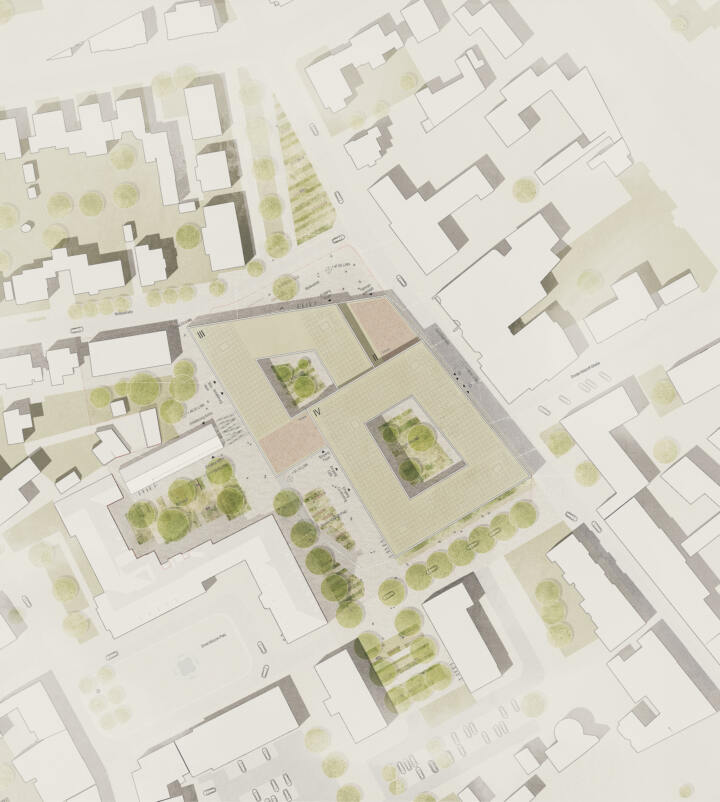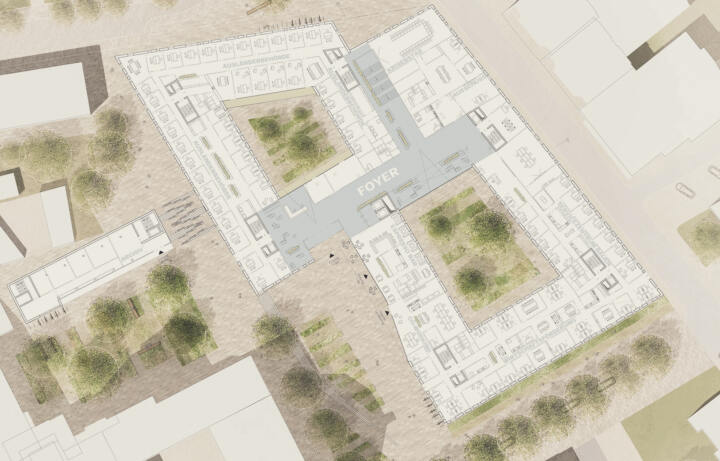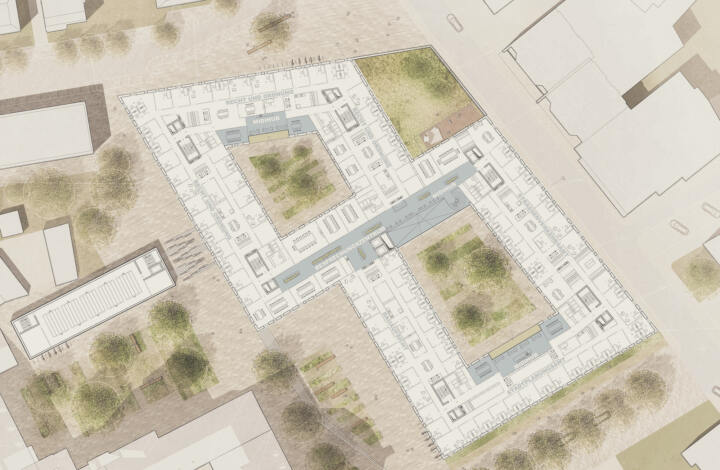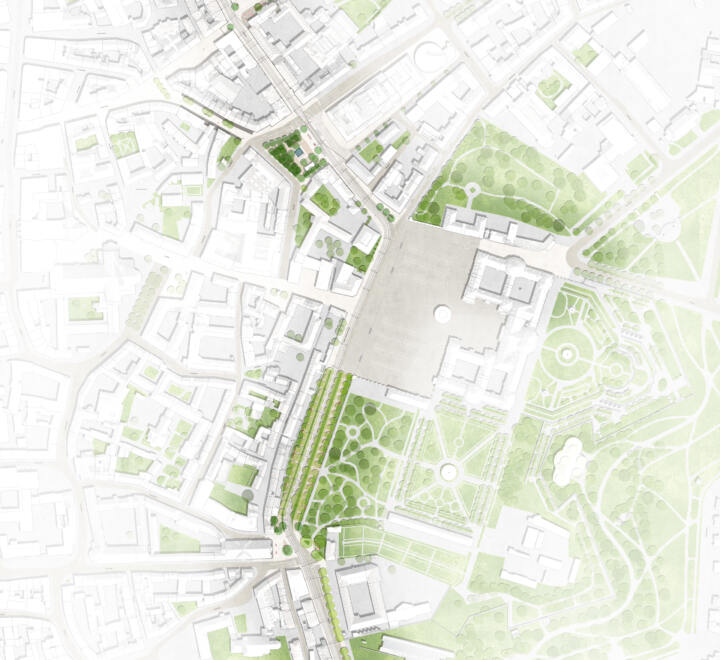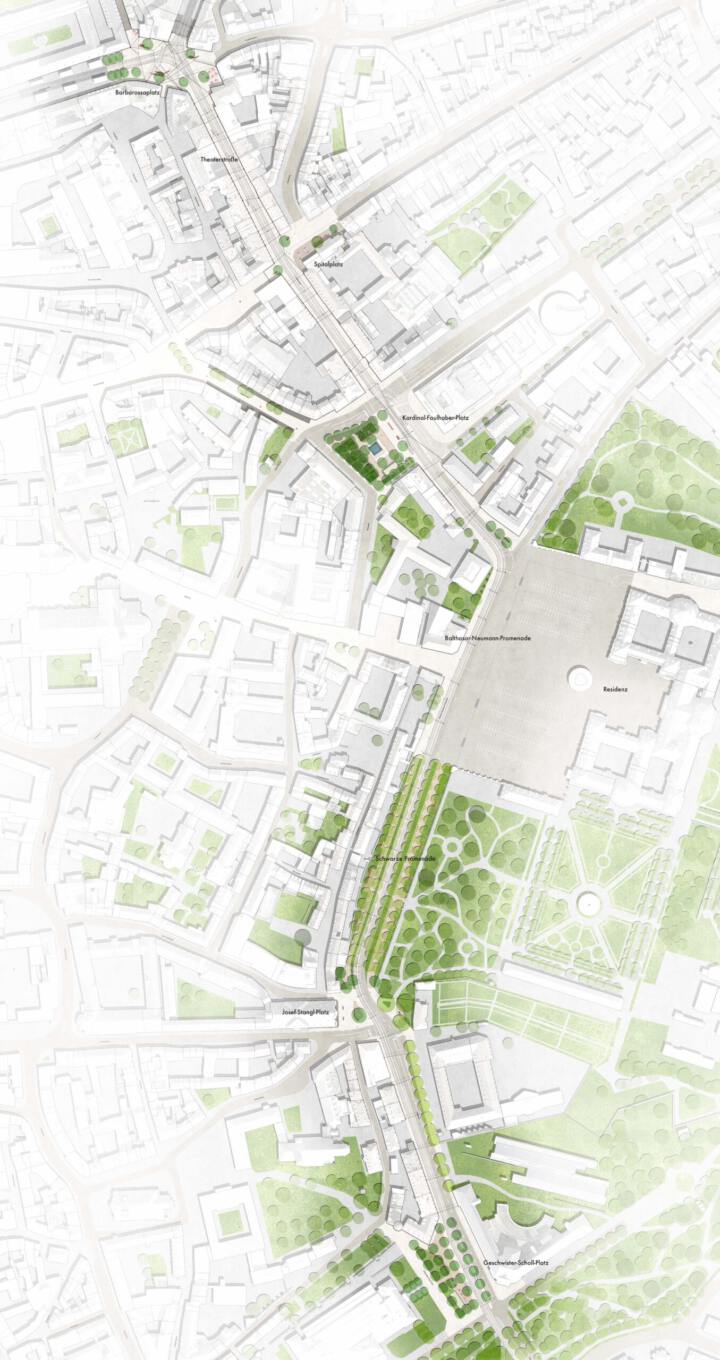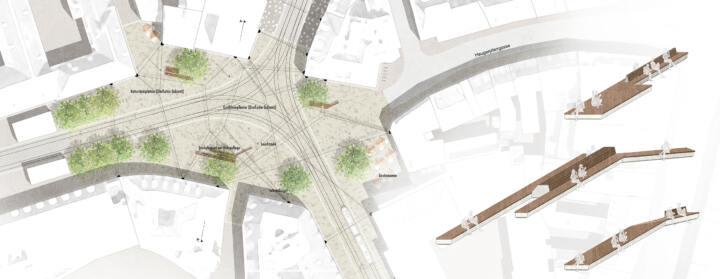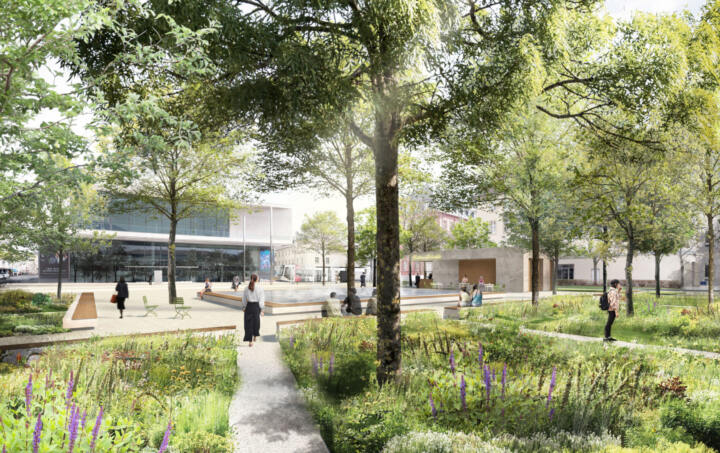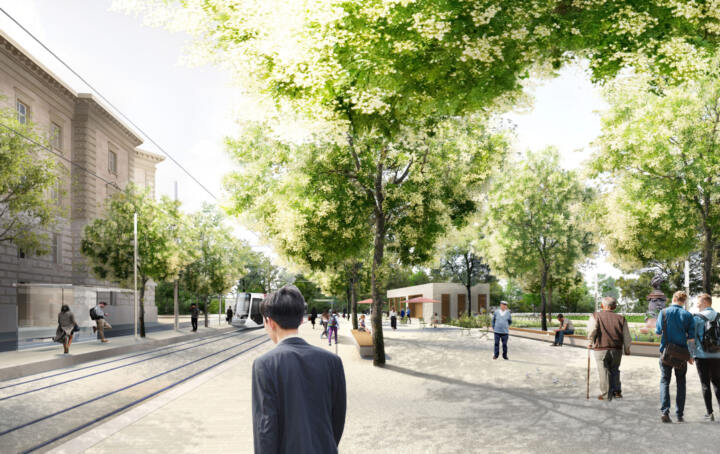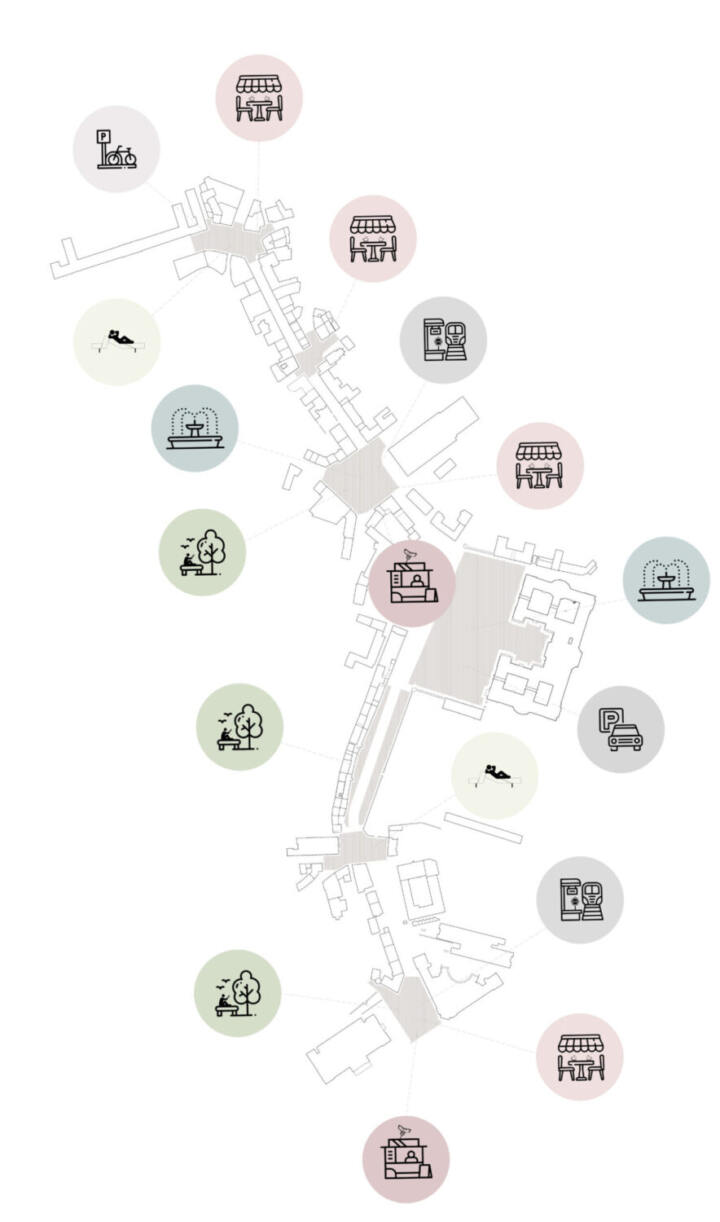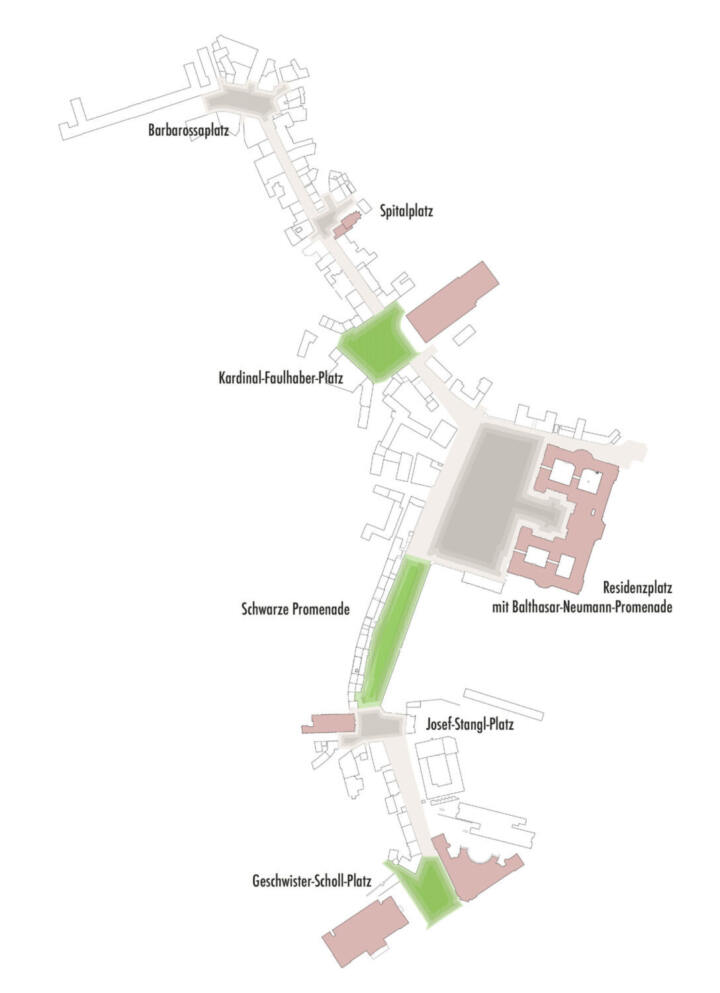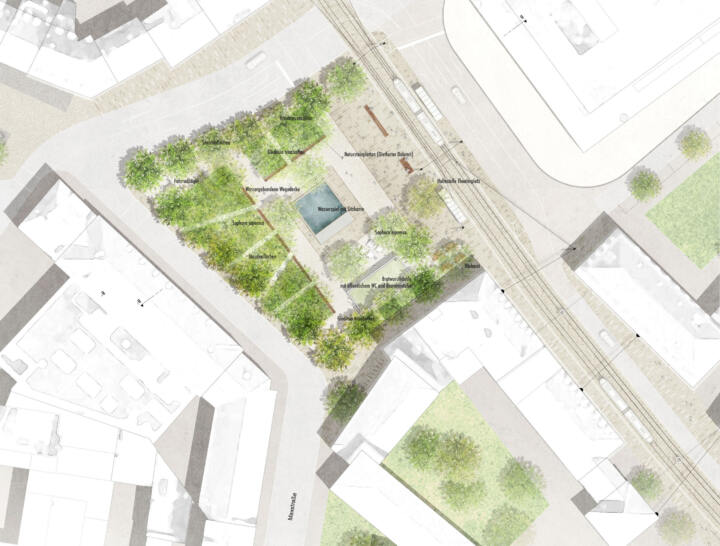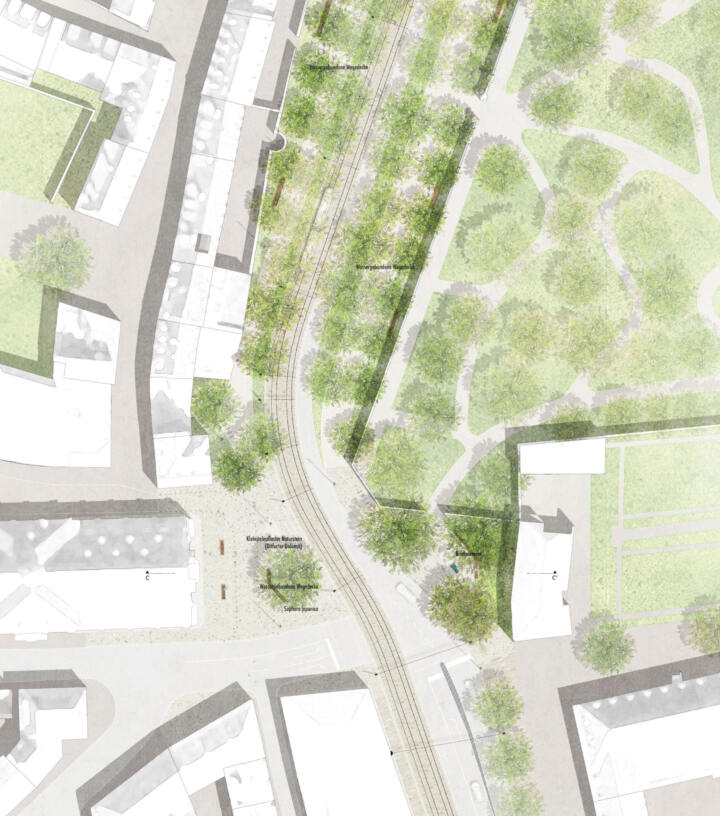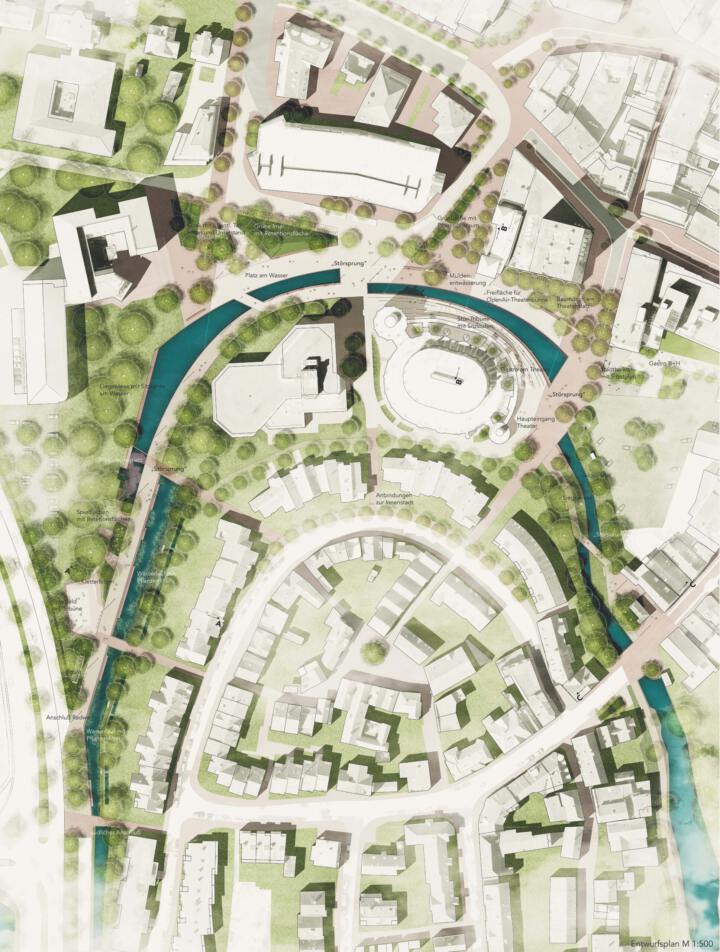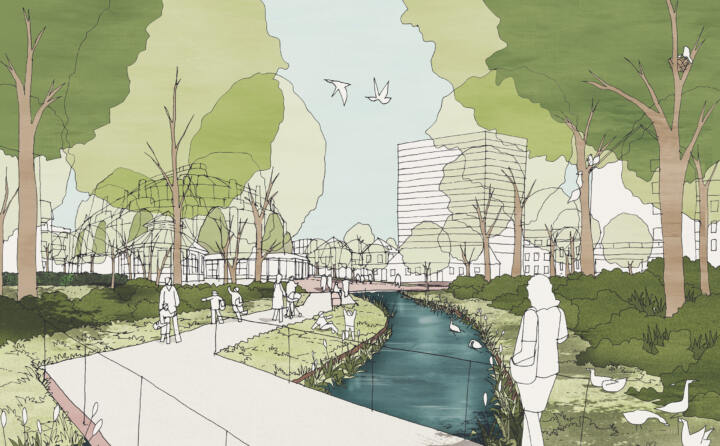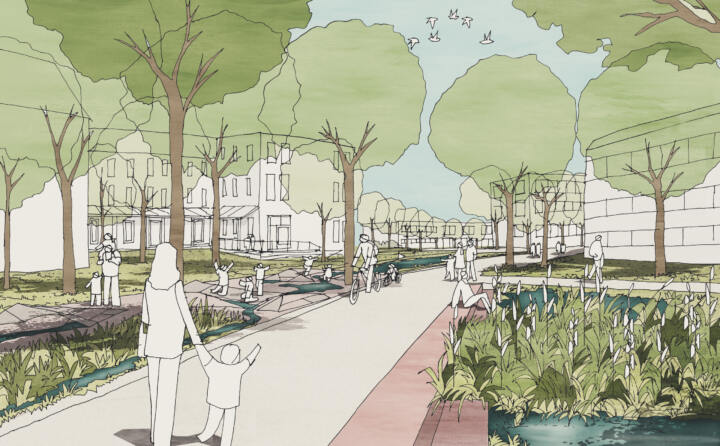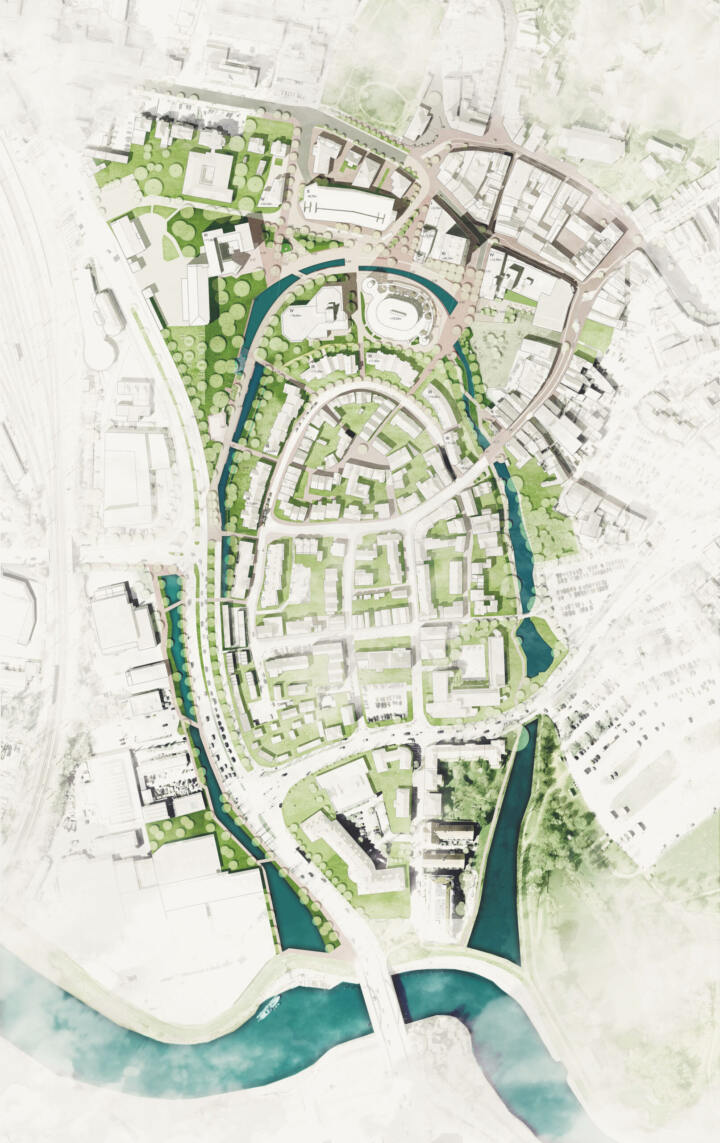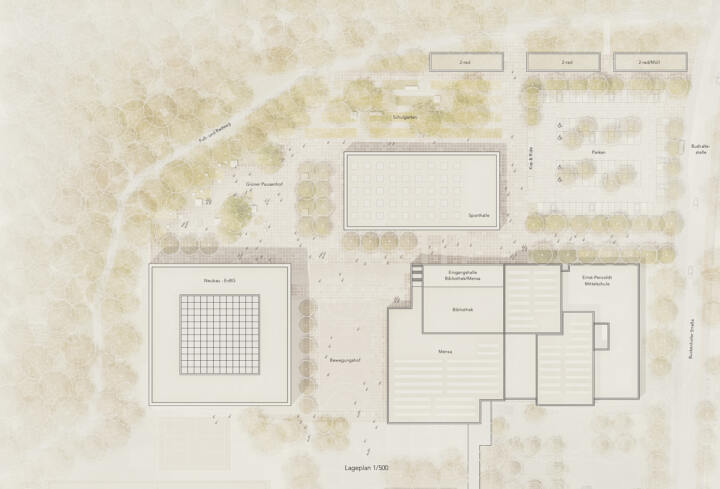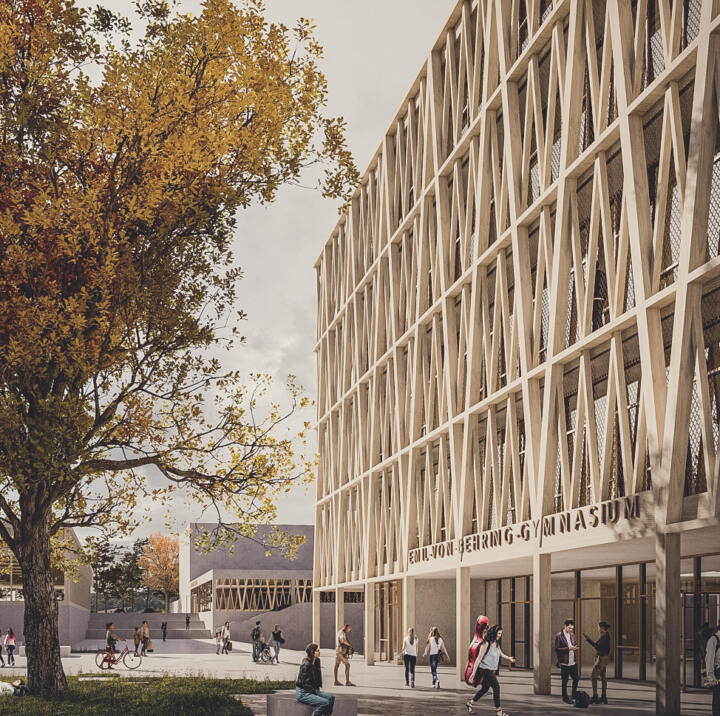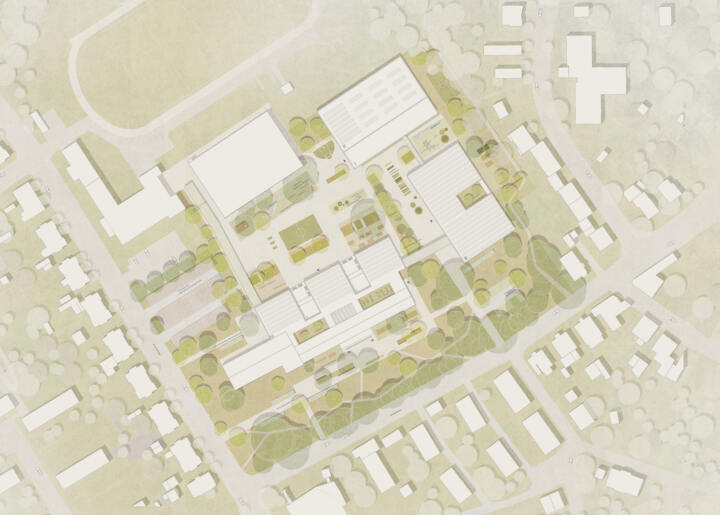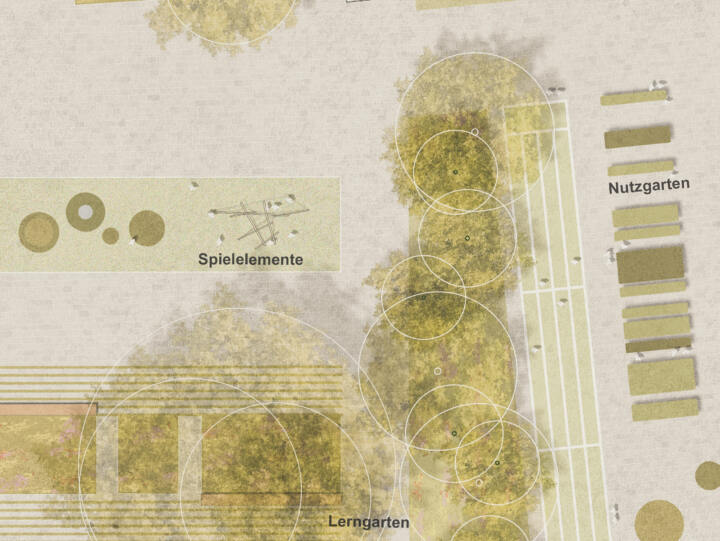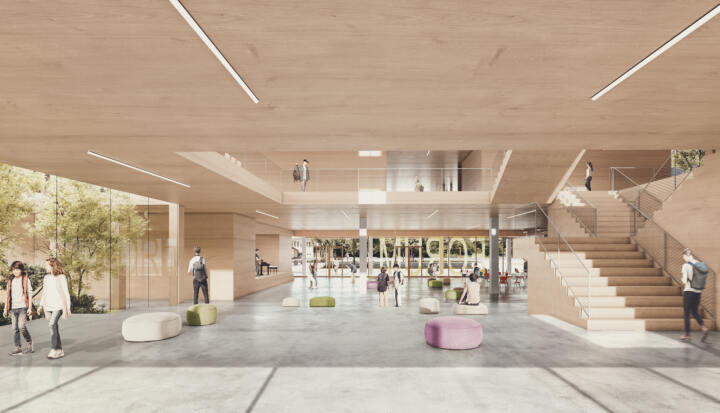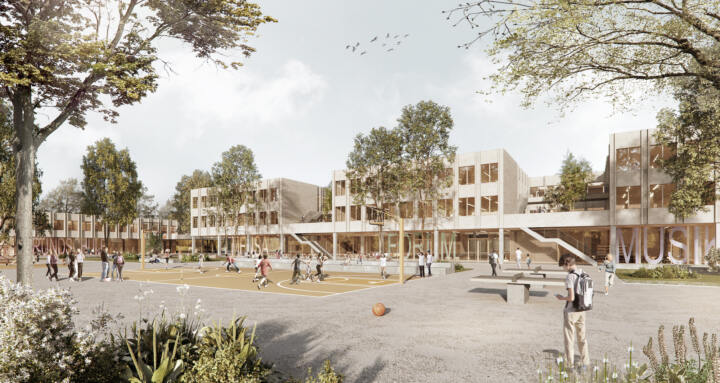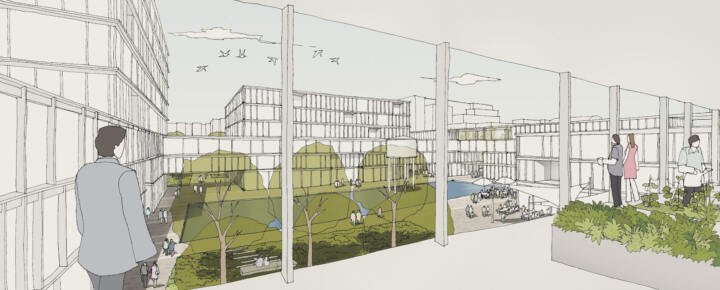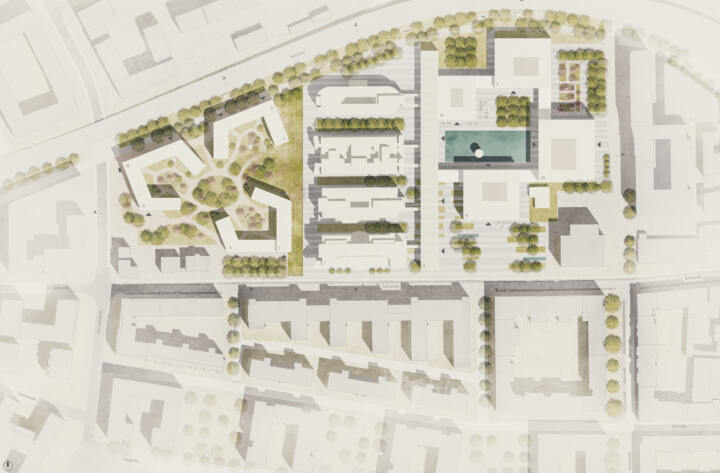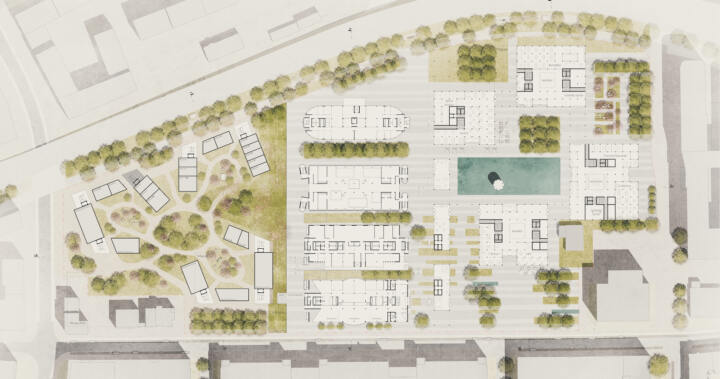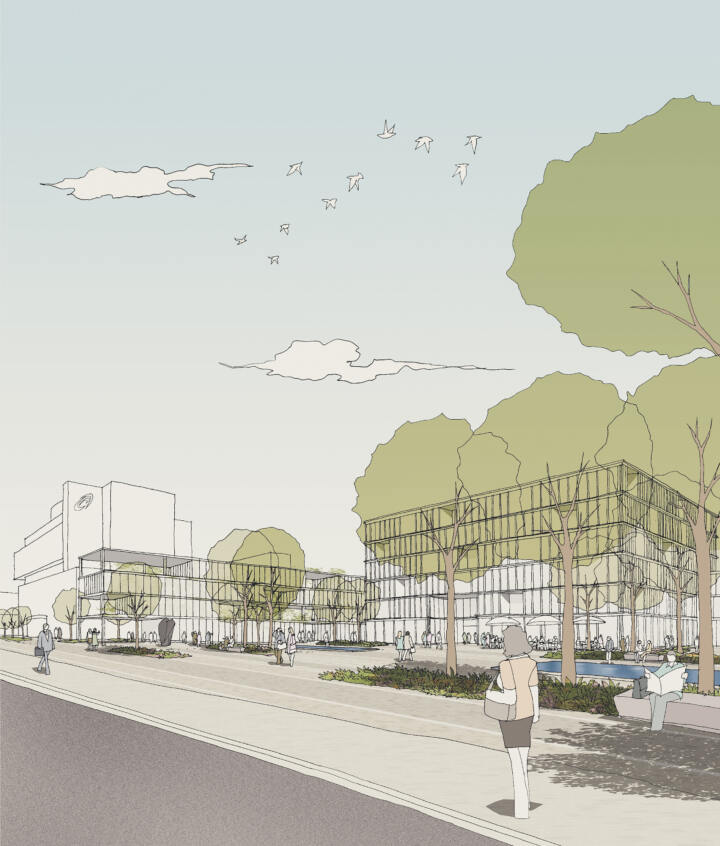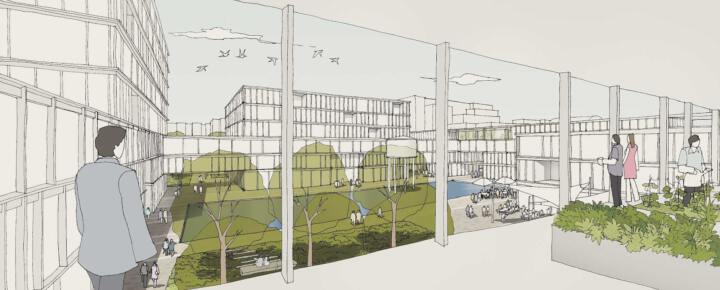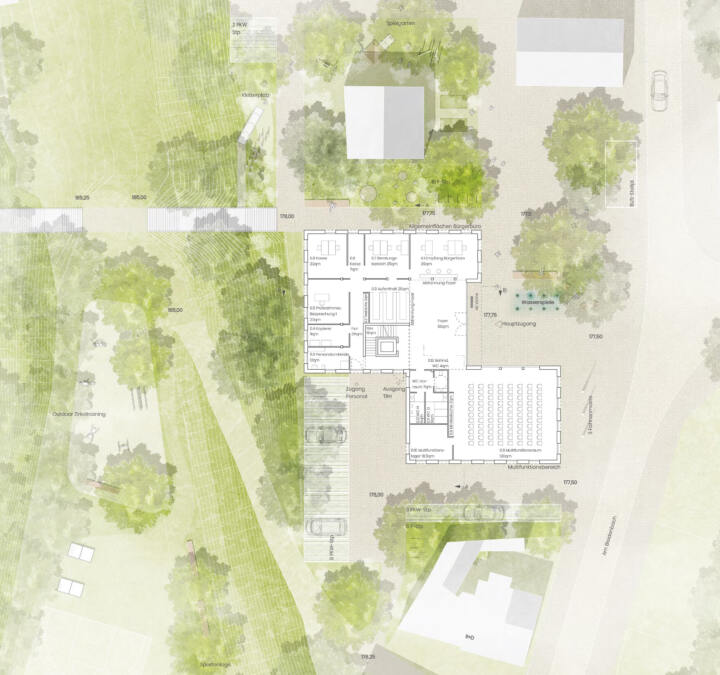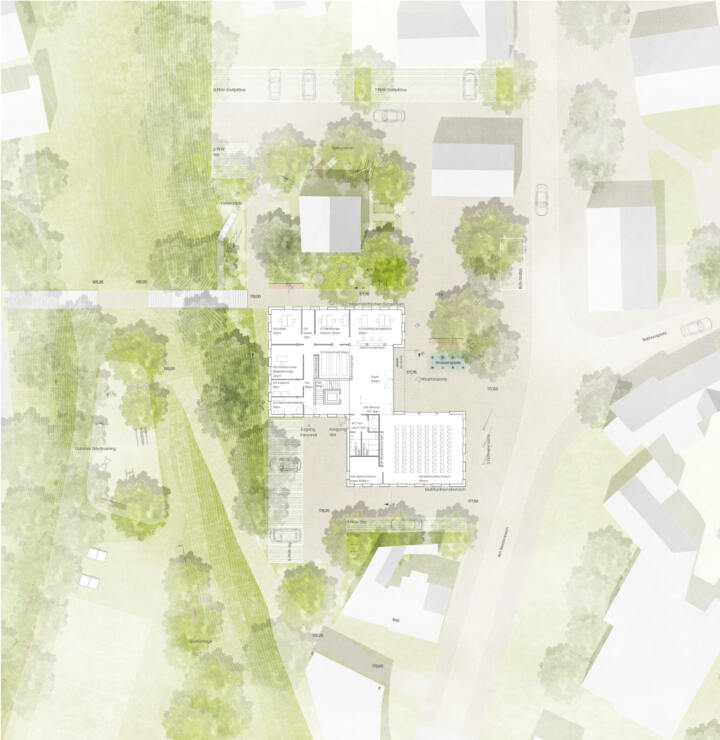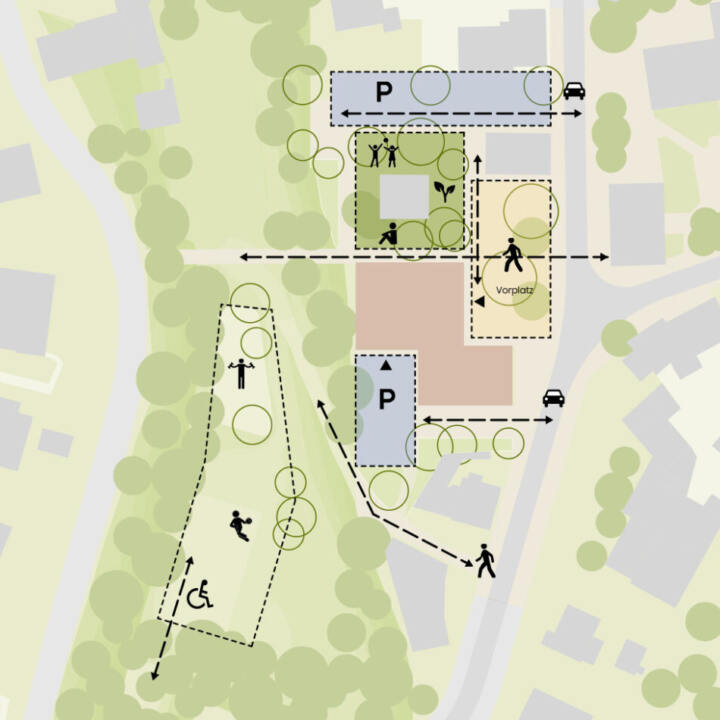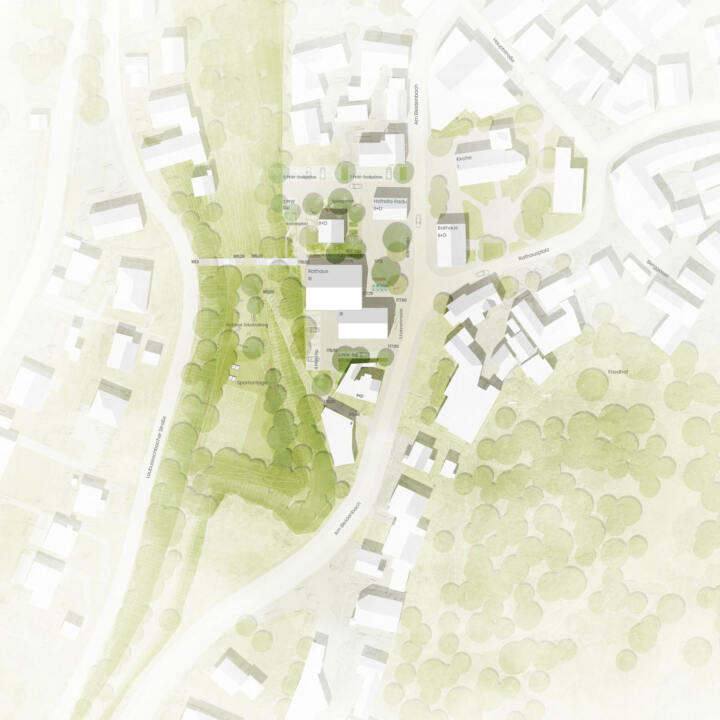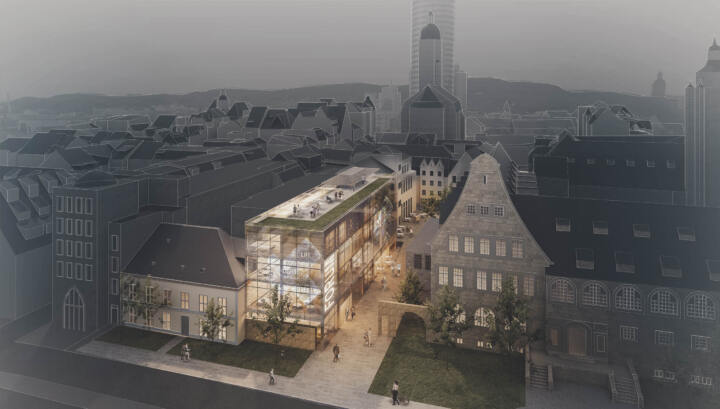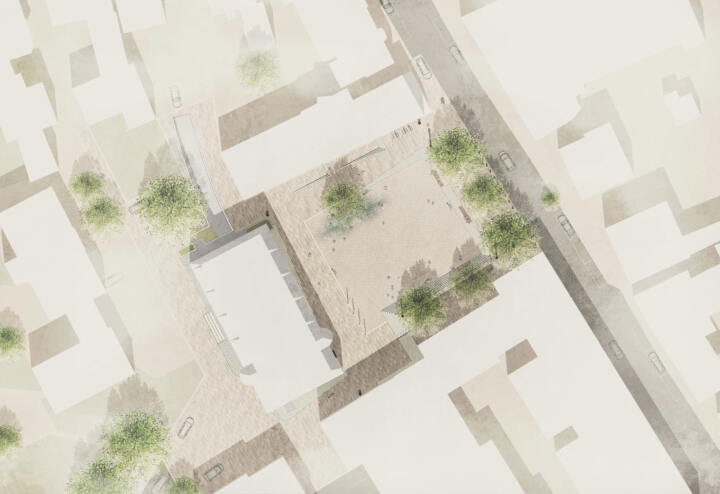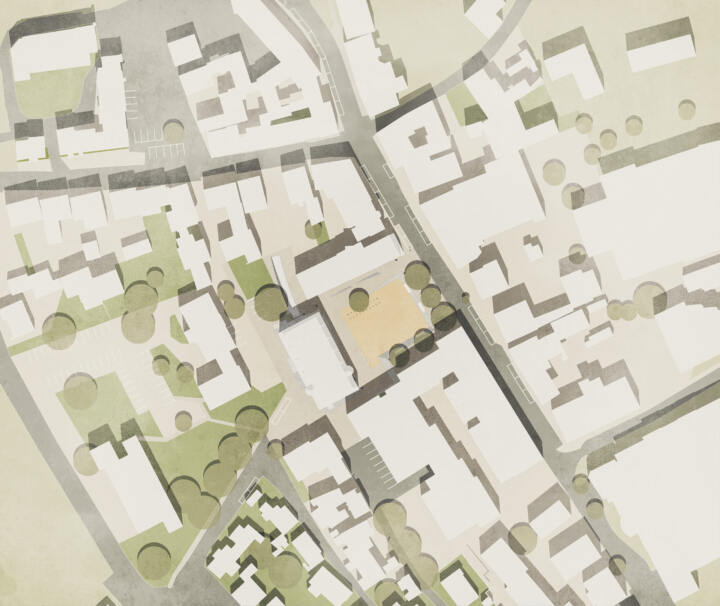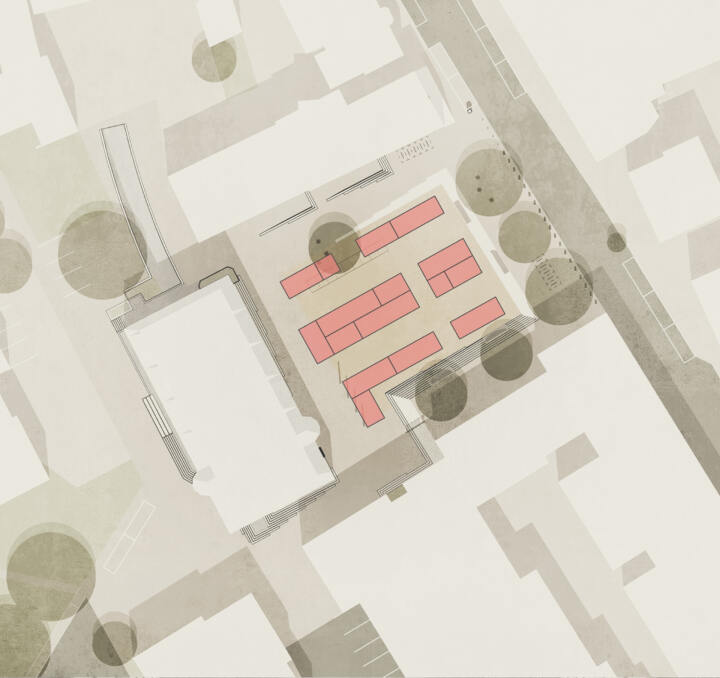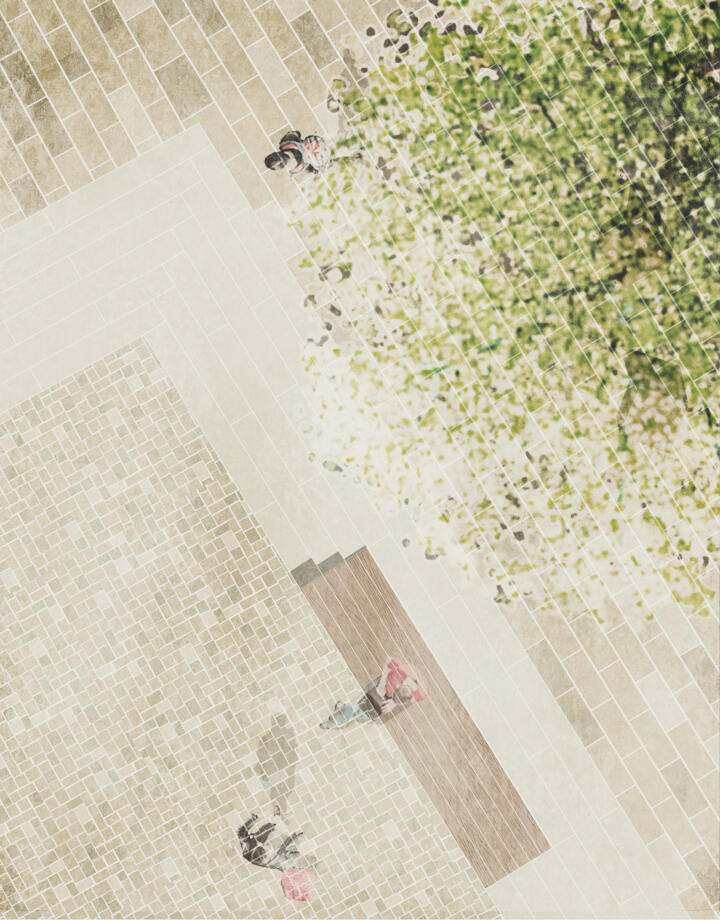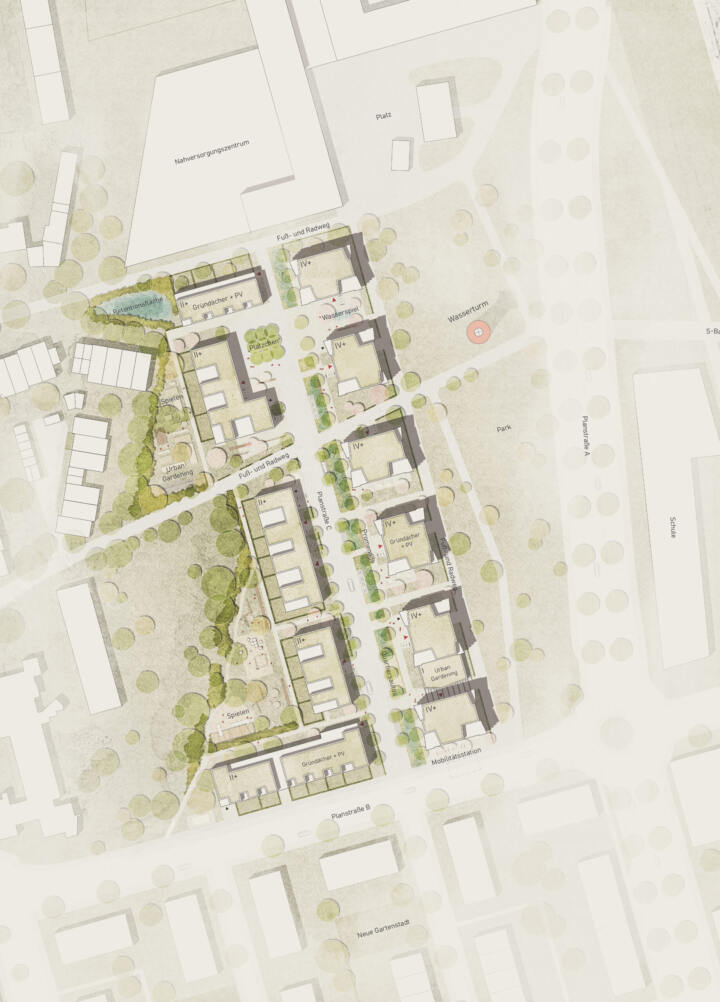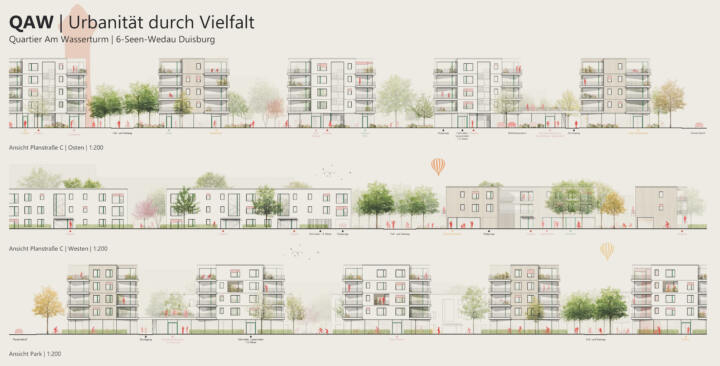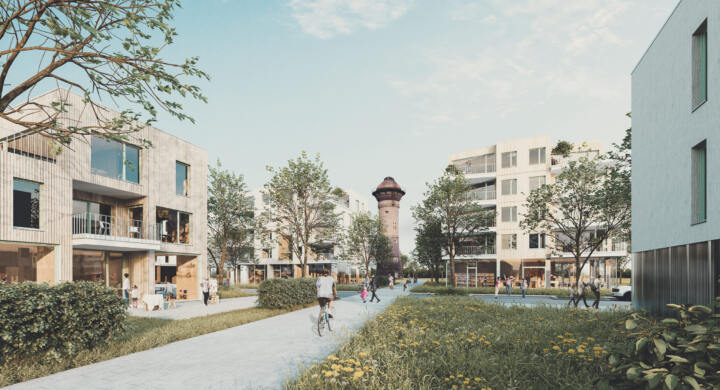Town Hall extension at Droste-Hülshoff-Platz | Bottrop
Recognition | Town Hall Extension at Droste-Hülshoff-Platz
Bottrop
In cooperation with Lepel & Lepel
The landscaping concept for the Town Hall extension displays clear-cut linearity and employs recurring elements and a long vista to connect the Town Hall with the inner city.
The proposed scheme envisages a variety of spaces, each with a different quality. In the north, a pocket park will create a central square, with bicycle parking and seating. Adjacent to this is the Town Hall garden, which can be accessed from the back of the new building via a staircase with an integrated ramp. The Town Hall garden is divided into sections by a planted area, with trees and raised beds as well as seating. Passing by the Town Hall garden, one reaches Droste-Hülshoff-Platz, which is subdivided by a flight of steps and a row of trees. Above, a space for lingering is created with loosely distributed seating, and incorporates an outdoor café, and the staircase steps provide a place for people to sit. The lower part of the square is designed as a wide traffic-accessible thoroughfare that extends the visual axis to the city centre.
The building’s inner courtyards evoke a jungle-like atmosphere with their generously planted vegetation of varying heights.
The landscaping concept uses various measures to address climate change and also contributes to improving the city’s climate. Trees provide shade, while light coloured surfaces are designed to help mitigate warming. Furthermore, low-maintenance flowering beds, shrubs and lawns as well as large joints and lawn paving sets allow water first to seep away, then be stored, and finally evaporate. Excess water is temporarily stored using infiltration systems. The roofscape also contributes to evaporation through being intensively planted, and in addition roofs are equipped with photovoltaic panels.
Open space and square design for the new streetcar line Hubland district | Würzburg
3x 2. Prize + 1x 3. Prize | Open space and square design for the new tram line in the Hubland district
Würzburg
In collaboration with Benkert Schäfer Architekten
The new tram line to the new Hubland district runs through the city centre and, with the opportunity to redesign the space running alongside it, will create a greatly enhanced quality of open space for the city of Würzburg. The redeveloped traffic infrastructure and traffic organisation in the city centre resulting from this new intervention will also allow existing urban spaces to be reconfigured: the redesign will address former deficits in terms of their ambience and function, climatic resilience, identity and perception, how spaces connect, plus mobility issues and the amount of green space. Depending on the urban context of each one, these spaces will be transformed in a contemporary and sustainable way by providing new functions and enhancing the urban environment. The design aims to create a multitude of uses through connecting a network of open spaces into the adjacent existing urban fabric, while safeguarding green spaces and ensuring an ecologically sustainable approach to urban space.
Large trees will be planted in places that are suitable in terms of concept and character, whereby the extent of new planting will always take account of the planned use and the appearance of each space. In this way, an appropriate balance of “hard”, stony space and “soft”, green urban space will be created along the new tram line.
Barbarossaplatz – an important urban link between Kaiserstrasse, Juliuspromenade and Theaterstrasse – will be redesigned as a triangle of tracks, thereby unting its two functions as both traffic junction and pedestrian zone. The square, which is extensively enclosed in terms of urban development, opens up important vistas to the surrounding urban space, and these will be further strengthened in the redesign. The redesign integrates existing trees and these will then form a framework for supplemental planting. Large multifunctional seating elements are arranged in the three surrounding areas, corresponding to the vistas. The resulting square has an attractive ambience and thus serves as a meeting point in the city centre, as well as providing orientation for the surrounding urban spaces. The orientation of the uniform natural stone slab paving takes its cue from the adjacent street spaces and their surfaces.
Kardinal-Faulhaber-Platz
Kardinal-Faulhaber-Platz will be enlarged in the course of the redesign and will then be of an appropriate size to function as an important urban space. Spatially, it is oriented towards the new tram stop and the theatre. A new frame of trees and planted areas will open it up towards the theatre and separate it from the surrounding traffic areas. The trees will be planted in the adjacent green spaces and in the water-bound path surface that frames the middle of the square, with its large water feature clearly defining the centre, with seating around the edge.
The paving of the square consists of large-format natural stone slabs, water-bound pavement and green areas. The dimensions of the square will extend to such an extent, that it clearly refers to the theatre. The “Bratwursthäusle” kiosk is a rectangular structure whose design is derived from the square and the theatre. Green areas are planted with perennials and serve as retention areas. Rainwater that is retained on the square is either fed underground to the trees, seeps away, or evaporates, creating a green city square with park-like character that offers visitors a cooling microclimate in the hot summer months.
Josef-Stangl-Platz
The surface area of Josef-Stangel-Platz will also be extended by reducing the adjacent trafficked areas. On one hand, the church of St. Michael is thus given an appropriate forecourt and a new atmosphere; on the other, the square extends across the streets and includes the areas that border the courtyard garden, thus creating an entrée to it. On the square in front of St. Michael’s, a solitary tree in combination with a large seating element creates a shady place to sit, with the clear aim of integrating the church into the urban space, rather than eclipsing it. The large existing trees in the courtyard garden area will be retained and are embedded in planted areas, to ensure the theme of the courtyard garden is continued into the urban space, thus removing the existing clear-cut separation of the two.
Access to Domerschulstrasse via the square is subordinate to pedestrian and bicycle traffic and is zoned by means of suitably arranged bench elements, organised in such a way that traffic is clearly directed. Areas of water-bound pavement mark the recreational areas on the square, and the forecourt surface consists of a small paving-stones, providing a suitable framework for the significance of the church and alluding to its history.
Geschwister-Scholl-Platz
The location of Geschwister-Scholl-Platz, between the district court, the university building and Ringpark, has an urban significance that will be further enhanced with the new tram line and the associated tram stop.
The traffic areas are being redesigned to allow the square to be further expanded and its quality to be improved. In order to make the square clearly recognisable, a gridded grove of trees is planned across the entire area of the space to link up with the Ringpark. The basic structure is formed by water-bound path surfaces, and planted areas which are oriented towards the university building, continuing the existing spatial structure.
The café “Brotzeitstube” on the square adds to the ambience and the square’s frequency of use, which is further helped by seating elements beside the planting, thus turning the square into meeting place. Following the redesign, Geschwister-Scholl-Platz will play an important role in the urban context, as it serves both as a link between the adjacent spaces and as an entrance to the Ringpark, thereby creating an important local landmark.
New Störschleife | Itzehoe
2. Prize | Neue Störschleife
Itzehoe
In collaboration with Heidt + Peters mbH
‘The Stör is jumping’
Close to the main square in Itzehoe, a new and high-quality open space will be created where people can experience both the ‘Neue Störschleife’ (a new loop in the river Stör) and the waters of the Stör river more tangibly than in the past. Essentially the ‘Neue Störschleife’ continues to follow its previous course however, through introducing an offset, it has been possible to introduce a new space including several water features, and various sub-areas plus multi-functional uses. The central space, north of the AOK building and the theatre, has a special significance as it is one of the few large, open squares in the city centre. This entire area will be designed as barrier-free accessible and it will have a distinctive quality through the introduction of arched benches, plus a variety of places to stop and relax overlooking the water. It also offers plenty of space for events, festivals and performances, or an open-air market, all of which can be experienced from the large staircase and steps with seating, located to the north of the theatre. The clinker pavement has been designed to link in with the adjacent shopping street.
In addition to the central square, various sub-areas have been created along the ‘Störschleife’. In the west, at the start of the watercourse, there is large-scale constructed wetland that resembles a natural water surface, and its seating steps invite visitors to linger. On the east side of the watercourse there are private spaces, allowing owners direct private access to the water. Along the watercourse, meadows and areas for play and sports activities invite visitors to linger too. One distinctive feature is the water playground area, allowing people to come into direct contact with water. Following the watercourse further to the east, a more natural picture emerges. The lushly planted flattened banks offer valuable shelter for animals.
In addition, a wide path for cyclists and pedestrians runs along the near-natural watercourse, linking up the various areas.
Sustainability
Another focus of the design is to ensure the scheme is sustainable. The scheme uses only shrubs and plants that have proved resistant to urban climates, and the overall aim is to have a high diversity of species. This high biodiversity is achieved not only through different tree species, but also through a mix of perennials and shrubs. These provide food sources and nesting opportunities for birds and insects, especially in the less frequented areas.
The choice of materials for the furniture was based on the design manual and only FSC-certified wood is being used. Existing natural stone will be reused and the clinker surfaces are all constructed using existing clinker material. In addition, the open space has numerous bicycle racks and efficient lighting is employed throughout.
Water cycle
The complete water cycle concept has been devised so that it contributes to increasing urban resilience. At the beginning of dry phases, for example, water levels in the system can be raised to positively influence evaporation in favour of the microclimate. If heavy rainfall is predicted, the water levels can be lowered in advance in order to exploit the retention capacity of the system.
Emil-von-Behring Secondary School | Spardorf
1. Prize | Emil-von-Behring Secondary School
Spardorf, Erlangen
In cooperation with Babler + Lodde Architekten
The open areas on the school campus are arranged as well-defined external spaces, while the existing topography is skilfully used to define the individual subspaces. These subspaces are effortlessly connected by means of a tiered arrangement of seating with integrated stairs and ramps. A square grid acts as a linking element, determining both the division and design of the interior spaces, as well as the squares and paths of external spaces. Geometric blocks and rows of trees take up the urban structure, accentuating the built context. A continuous surface made up of 1.25m x 1.25m slabs picks up on the building’s modular grid, tying the open spaces together. Variously sized seating decks are woven into this grid. In addition to three oak trees, all of which merit protection, a large number of existing trees can be preserved.
The lower-lying courtyard between the canteen and the secondary school accommodates an all-weather court. In future, should more open space be required, this function can be relocated to the roof of the new sports hall and the former area added to that of the schoolyard. All trees will be planted in generously dimensioned tree pits and these will be additionally irrigated via tree trenches so they can be permanently maintained, even in times of climate change.
School Campus Gellershagen | Bielefeld
3rd Prize | School Campus Gellershagen
Bielefeld
In Cooperation with Atelier 30 Architekten GmbH
With the new extension to the secondary school and the new buildings for the primary school and triple sports hall complex, building work to the school campus in the Schildesche neighbourhood has now been completed. The schoolyard is flanked on all sides by the school buildings, creating a protected area in which children can move around safely. Service areas are clearly zoned, while axial vistas and paths link the school campus with its urban neighbourhood.
These additional campus buildings set the context for a reorganisation of the open spaces around the campus, while also acknowledging the existing green belt on Schelpsheide. The secondary school is accessed centrally, either through the courtyard via the street “Am Brodhagen” or from Schelpsheide. At the heart of the campus lies the large playground, while a swathe of greenery separates the secondary school from the primary school. Dedicated areas for games are embedded in the uniform pavement of concrete pavers in finely nuanced shades of grey and beige. These areas are delineated by playful markings, by grass-permeable pavers or by colour, none of which present an obstacle to the children’s need to move around freely. Plenty of opportunities for primary school students to play – for example just romping around or climbing activities – are visually delineated by lines and fields in the surfacing, inspiring children to invent new hopping, running, and balancing games. Both the kitchen garden and the green classroom are located on the quiet east side. For secondary students, in addition to age-appropriate sports activities, there are outdoor teaching areas. Wherever possible, surface water is fed into the vegetation via tree trenches to improve the water supply to the foliage, which leads to an increase in evapotranspiration.
Mainova Campus Solmsstraße | Frankfurt
Recognition | Mainova Campus Solmsstraße
Frankfurt
In collaboration with hks Architekten GmbH Erfurt
Greenery galore!
The Mainova site on Solmsstrasse is being expanded, and the site‘s existing buildings integrated into the plan. A key elementary element – the so-called “connector” – links the existing structures with the new and will serve both as an access route and as a space for bringing people together across the entire extended campus. In the west, a residential area with courtyards and underground parking is being created, and in the east, the new campus. To meet various safety stipulations, this arrangement entails zoning the public and private open spaces differently. Traffic will be calmed to create new pedestrian routes between buildings for employees.
The open spaces on the Mainova Campus take their cue from the overall organization of open spaces around the site. Lines of trees will delineate the extent of greenery towards the railway line. On the northern site boundary this green corridor connects an area dedicated to recreation, sports and play via a green promenade.
On the site these green structures are linked into the residential quarter via the urban groves of trees. The urban feel of the entrance to the tunnel at Birkenweg that leads to the Schönhof quarter further emphasises its urban character. A green hub of shady copses at its centre is open to the public and provides recreational and quiet zones among the residences’ courtyards. These inner courtyards themselves offer a framework and space for neighbourly exchange surrounded by the green facades.
The linear “Green Hill” separating the campus from the residential area, provides parking spaces for e-mobility, and flanks onto the access route for campus traffic. Over the underground car park entrances and exits, intensively planted vegetation links the existing buildings within the campus. The forecourt acts as the entrance to the city and provides access to the Welcome Centre, Service Centre, a café and an exhibition space. The Mainova Campus offers employees, visitors and neighbourhood residents a place to linger under the trees next to the water basin.
City Hall | Weilmünster
3. Prize | Rathaus Weilmünster
Weilmünster
In collaboration with Meurer Generalplaner GmbH
The New Town Hall Weilmünster is to be a lighthouse project in terms of inner-city integration, functionality and sustainability. The urban development concept envisages a town hall building consisting of two simple structures, which supports the structural unity of Weilmünster in this quarter.
A contemporary open space concept is being developed for the town hall square, which will provides in particular clarity through the ordering of functions and spaces. The result is a multifunctional square that connects the various spatial structures.
Special attention is paid to the water feature, which positively influences the microclimate through evaporation. Visitors can cool off by the water or observe it from a distance and enjoy the relaxing effect. The fountains are designed to be navigable. The fountains can also be controlled according to the time of day/season/ and weather. In the shade of a group of chestnut trees, benches are arranged in the area of the entrance. The square is planned in large stone pavers.
The material integrates the street and the opposite area around the old town hall. A generously designed new town center with a clear identity is created. The parking spaces are planned in infiltration-capable grass paving slabs. Bicycle parking spaces are planned near the entrance. Three flagpoles will be placed in front of the town hall, clearly visible from the street. The tree population will be supplemented with climate-resistant trees. In the idea area, at the listed barn, a children’s playground will be created. The upper plateau will be connected, in addition to a barrier-free access from the south, via a generous staircase. On this plateau different, generation-spreading kinds of play and sport are offered.
FORUM Communication Center | Jena

2. Prize I FORUM Communication Center
Jena
In cooperation with Behnisch Architekten
With the Communication Center Forum, the Friedrich Schiller University is creating a building in the city center of Jena, between the Inselplatz campus in the east and the historic city center in the west, planned according to ecological guidelines for attractive meeting and work opportunities between students and teachers. Conferences, exhibitions, gastronomic facilities and overnight accommodations will also find their place here.
The open space is not only seen as a pathway, but is interpreted as a communication and recreation area that presents itself in an open and inviting manner. This urban fugue and the FORUM will welcome students, scientists and interested people and accompany them during their stay in Jena. A ‘welcome area’ in the eastern ground floor area can be opened and extended towards the square, which increases the flexibility of use and connects interior and exterior space.
On the northern side, the staircase to the lower emergency exits is relocated and, with the green area and a generous bench, an additional lounge area is created here with direct reference to the square and the FORUM.


The café in the western ground floor area is slightly lowered opposite the path area and the square in the west. Here, a transition is created with seating steps and a staircase, which also invites people to linger.
The square in the west will be used for parking for the time being. However, the required 14 parking spaces will be arranged in such a way that the paved areas and part of the tree planting can already be realized in the first step.
In the second step, there will be further tree plantings and an addition of furniture, so that a small paved town square will be created here. The path surfaces will be designed with two different materials. Existing natural stone and new, large-format slabs symbolize the connection between history and the future. Benches and steps will be placed in front of the café in the band of slabs that separates these areas.
Town Hall Market | Bebra
1. Prize I Town Hall Market
Bebra
Traffic
The main area is free of car traffic and ideal for small events or a market. The new Rathausmarkt is intended primarily for pedestrians. The market can be reached by car and bicycle via the terrace on Nürnberger Straße. Bicycle parking spaces are located here for cyclists. On the northern side, there is a barrier-free access that can also be used by residents and the fire department, and on the southern side, the stores can be reached from Nürnberger Straße. The square is secured by the existing bollards. At the northern corner, the existing parking spaces can be supplemented by an e-charging station, which will make the Rathausmarkt more attractive and modern.
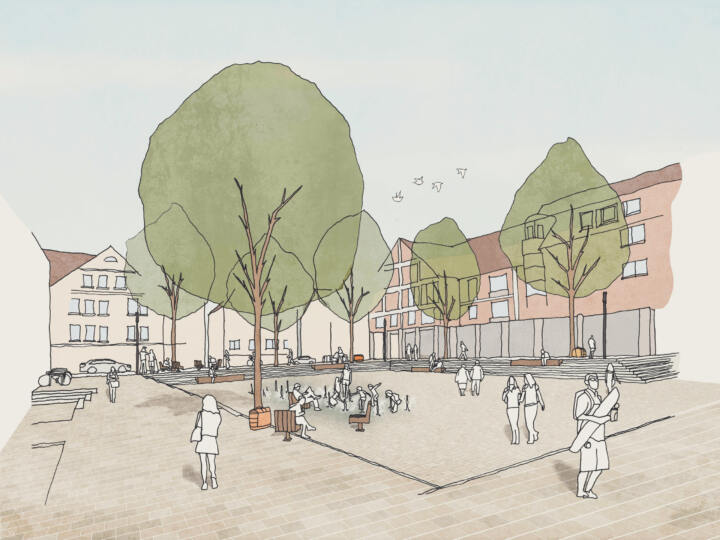
Material and Equipment
Currently, irregular paving and vegetation structures lie in front of the building facades.
paving and vegetation structures. The open space is defined by a targeted use of different floor coverings and materials to mark use and functional areas and at the same time to achieve a uniform coordinated appearance. The area of large stone pavers marks the movement space between the adjacent stores, the town hall and the streets. The inner plaza of natural stone forms the recreation area and provides space for markets, festivals and other events. The furniture and equipment is robust and timeless. The fountain area changes the microclimate. Visitors can cool off by the water or watch it from a distance and enjoy the relaxing effect of the water. The water feature will also be well received by children, who will enjoy visiting this space to romp and play. Four flagpoles and the new position of the memorial plaque in front of the town hall complete the square.
6-Lakes Wedau - Quarter at the water tower | Duisburg
1. Prize I 6-Lakes Wedau – Quarter at the water tower
Duisburg
In collaboration with Druscke und Grosser Architektur
The new residential quarter in Duisburg, with a water tower as an identity-forming element, will offer residents sustainable and future-oriented living space in the future.
In addition to a unique urban and open space planning concept, the issue of sustainability plays a decisive role.
Urban planning concept
Two ensemble groups are created, the so-called ‘neighborhoods’, which are linked via the centrally running Planstrasse C and the pedestrian and bicycle paths. Semi-public green spaces with different uses for the residents are assigned to the neighborhoods. Thus, open spaces with opportunities for play and recreation as well as urban gardening areas are created. The public area is dominated by the surrounding parking area. In addition, two plaza areas will be created to the north of Plan Street C and a mobility station to the south.
The creation of the two new communities will initiate a high level of communication among residents and strengthen the social aspects of the neighborhood. Architecturally, this is created in part by the diverse community uses located on the first floor. Among other things, youth rooms, community rooms as well as KiTa and small retail stores are planned. Above these, apartments with balconies will be realized. The outdoor space also invites interaction with each other through the shared play areas, urban gardening areas, tenant gardens and parking areas.
Sustainibility
In addition to social aspects and the promotion of these, the issue of sustainability plays a major role. The aim is to make the building as CO2-neutral as possible and to achieve the EH40 energy-efficient house standard. This is achieved primarily through the choice of a compact building structure with an advantageous A/V ratio. In addition, the roof surfaces will be green.
The importance of sustainable design can also be seen in the exterior. The new buildings blend harmoniously into the existing park and green structures. In addition, only a small amount of surface area is sealed and planting that promotes biodiversity is aimed for.

